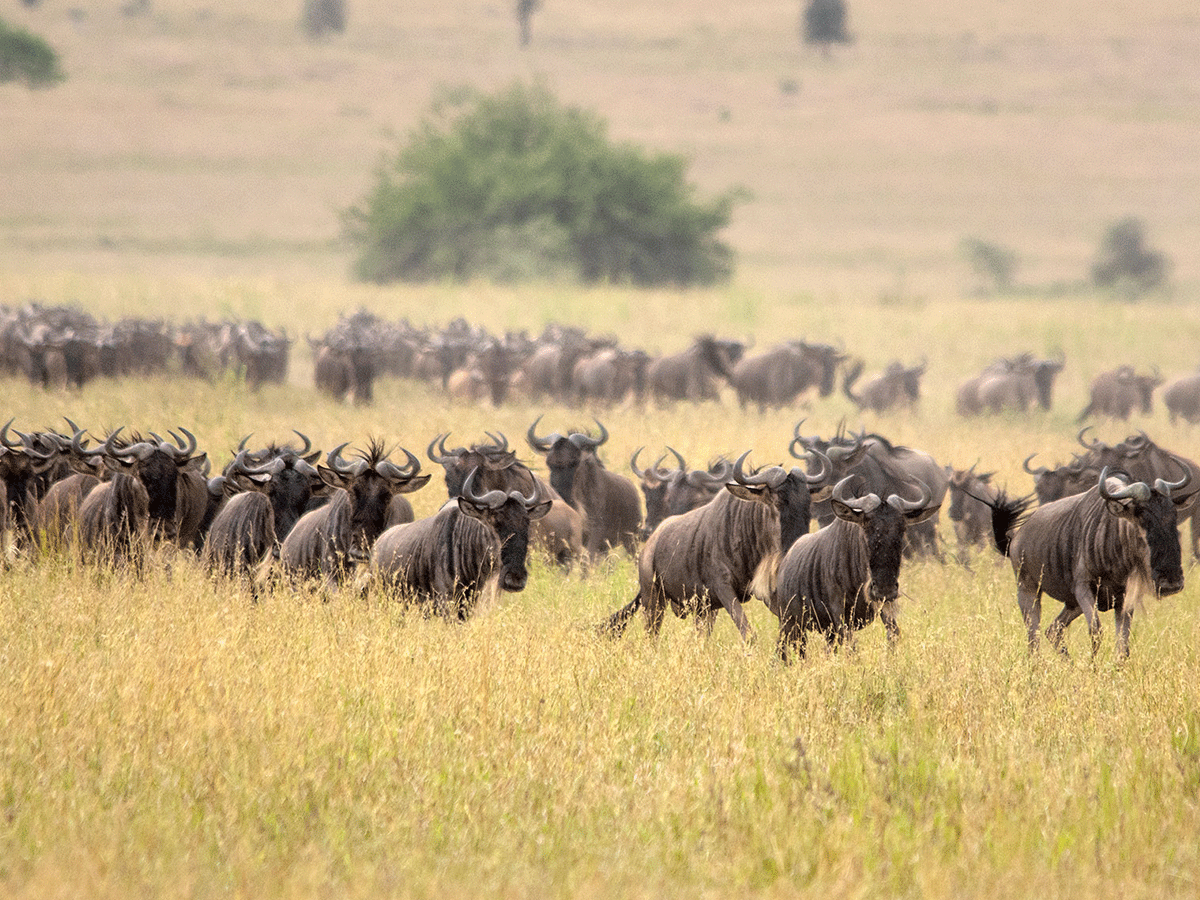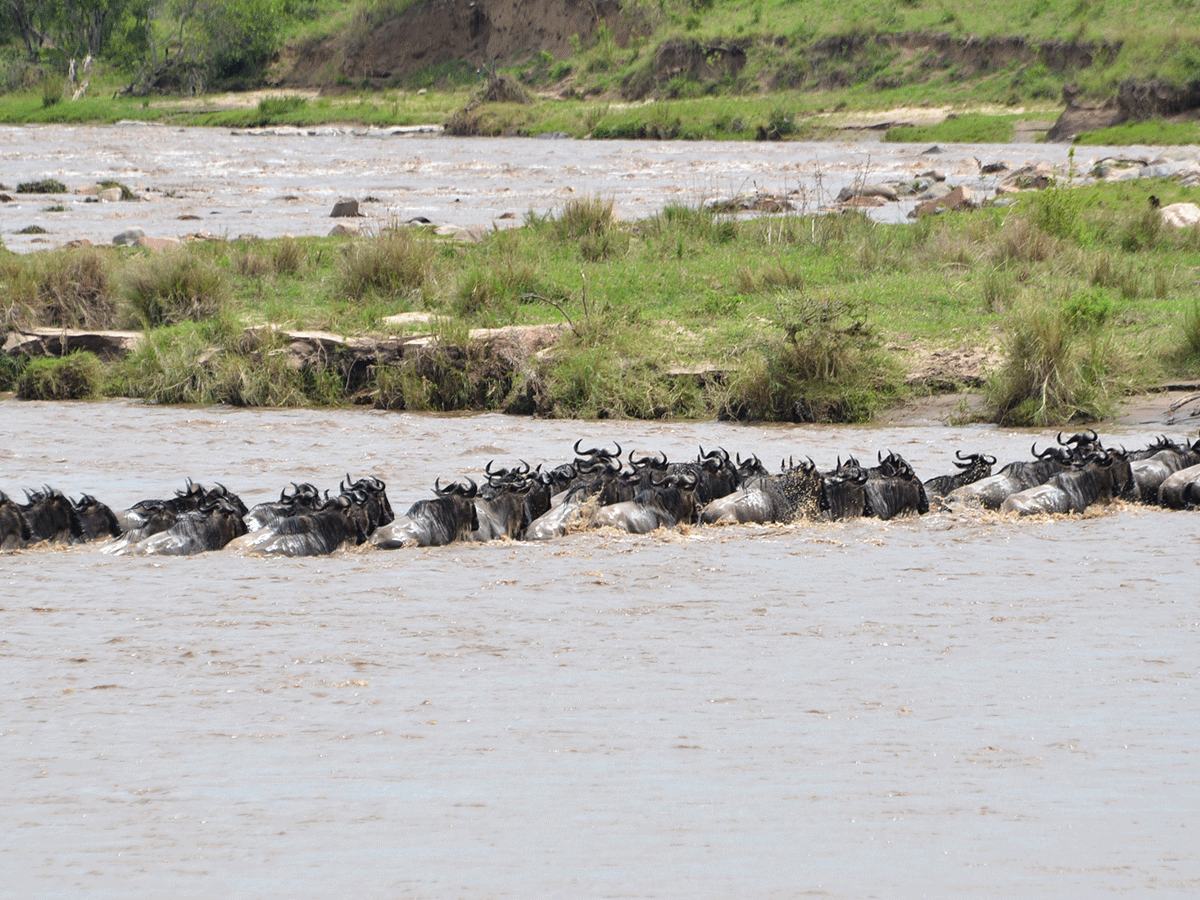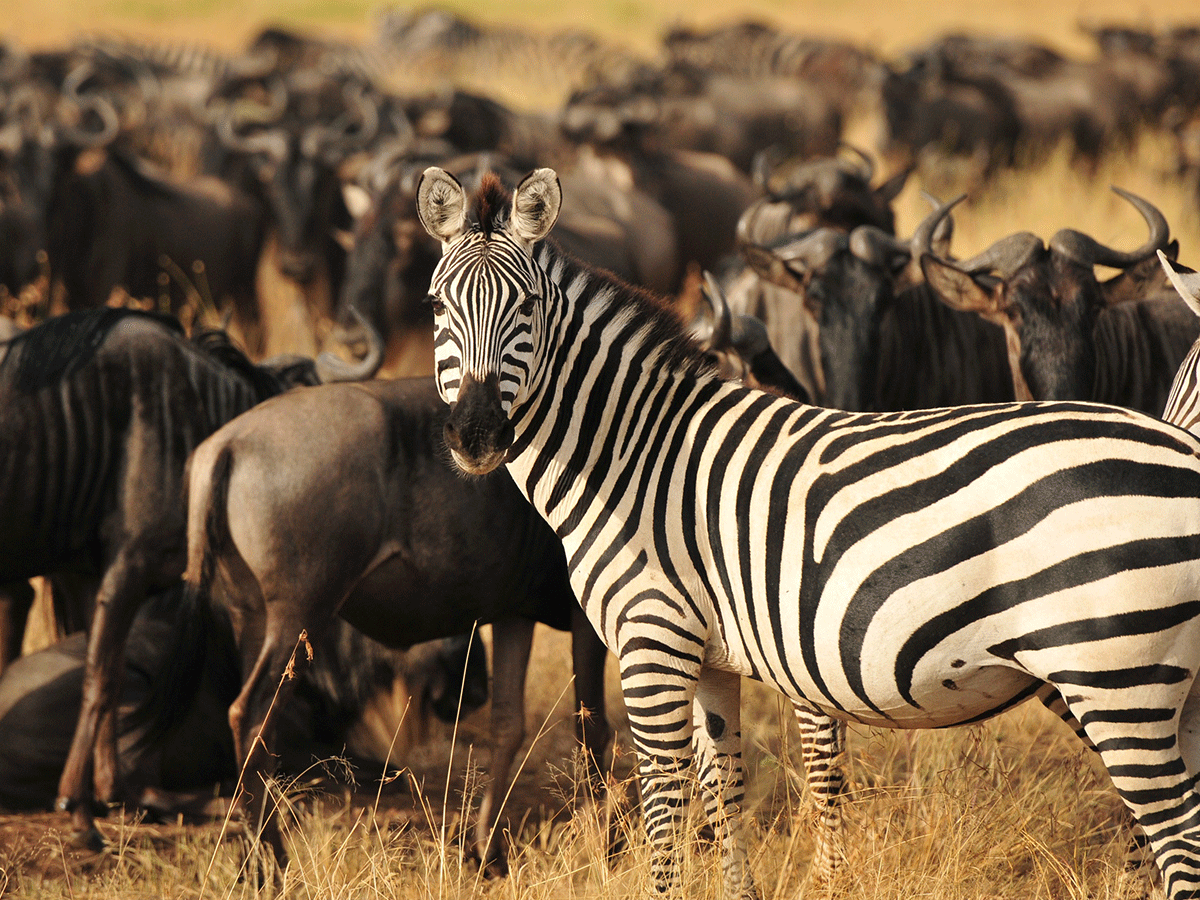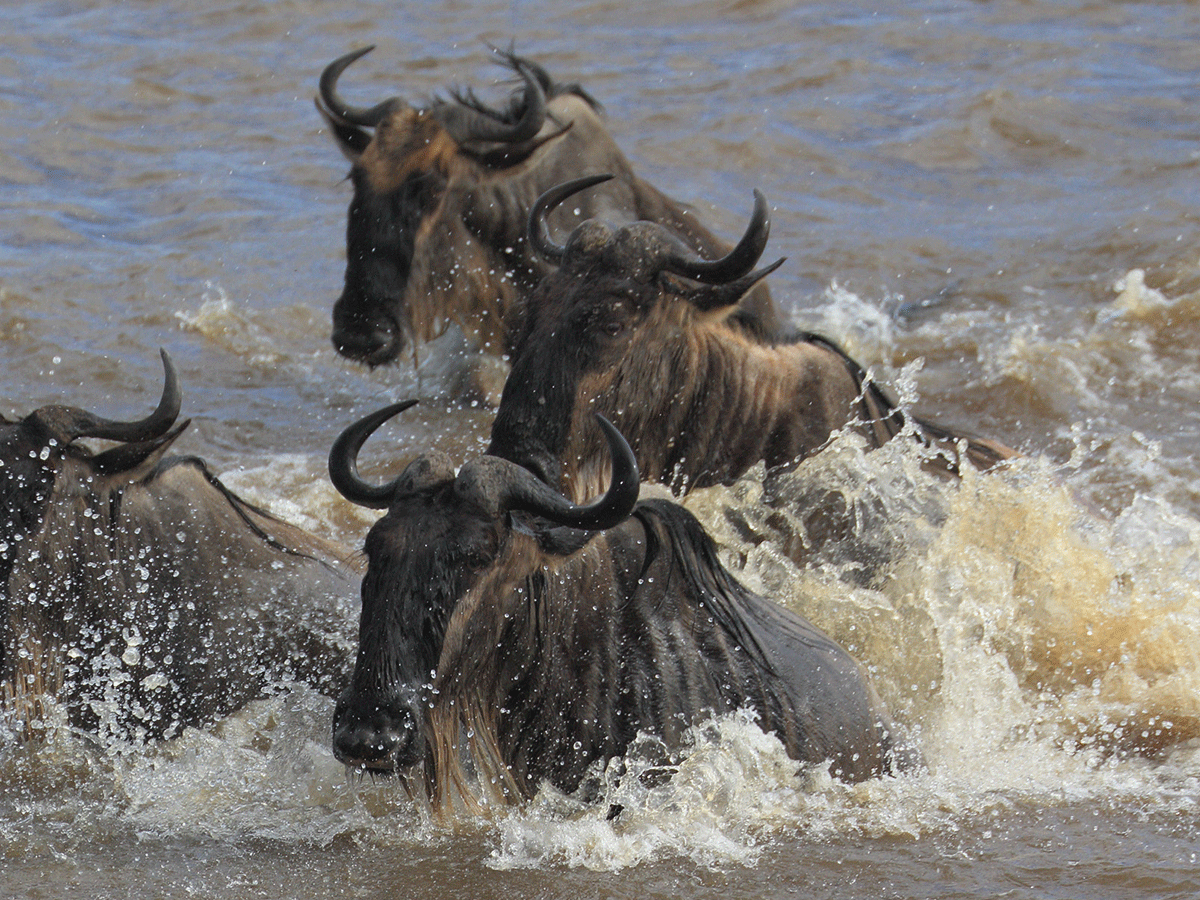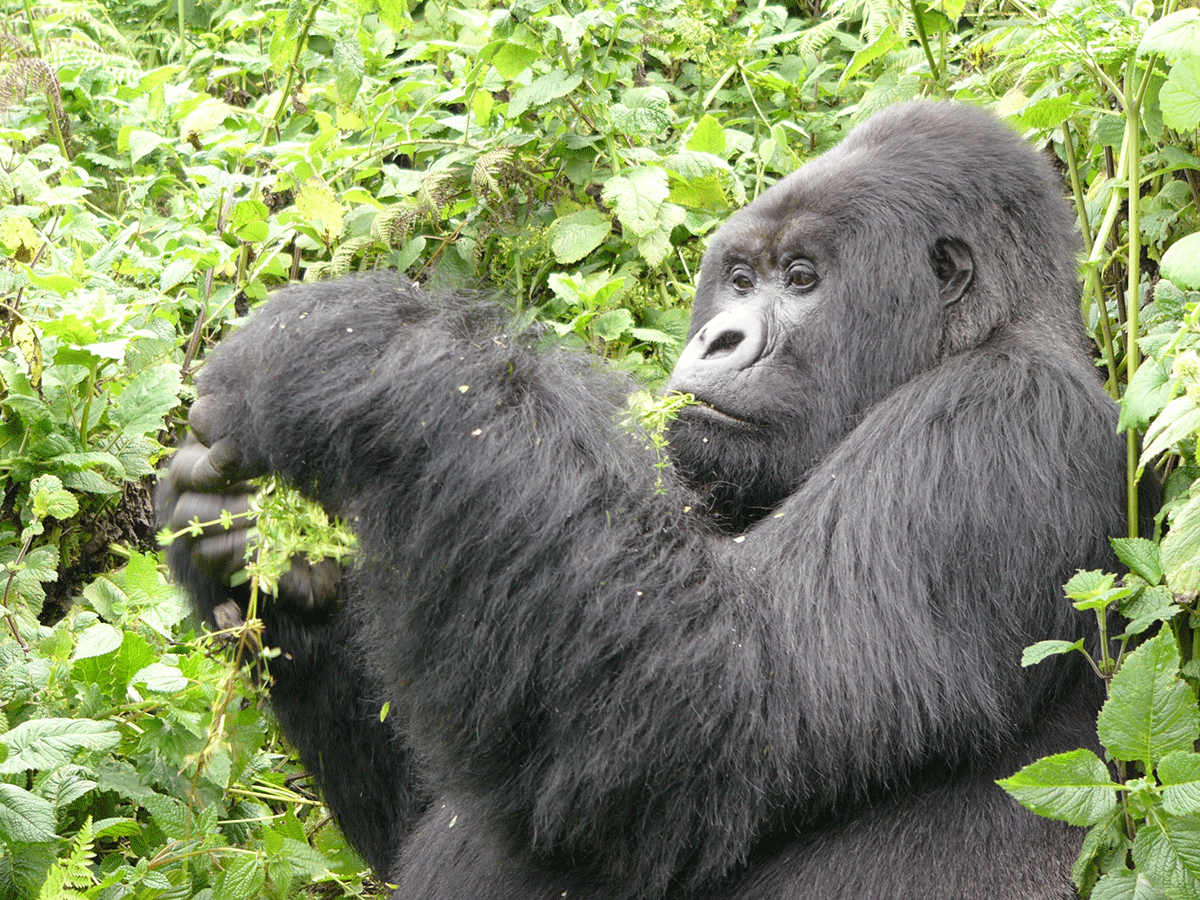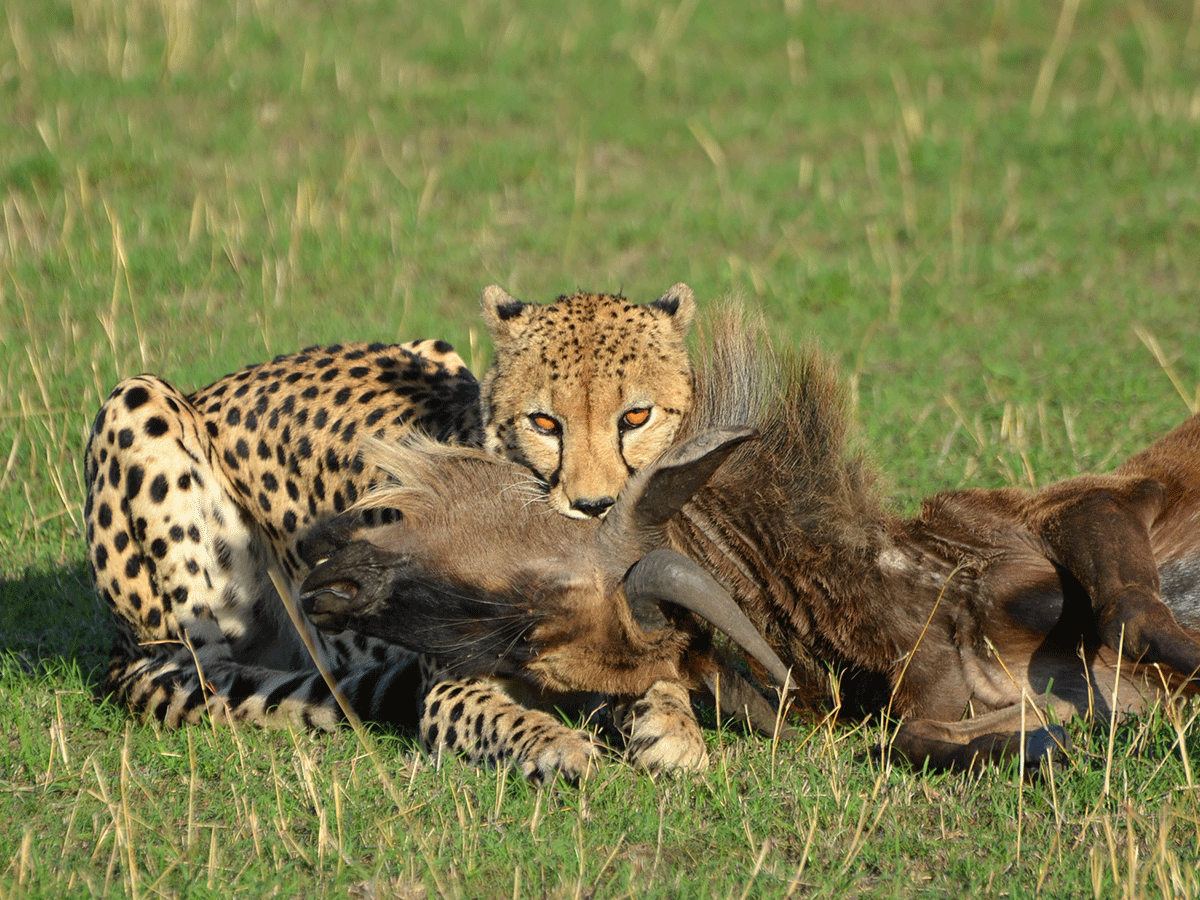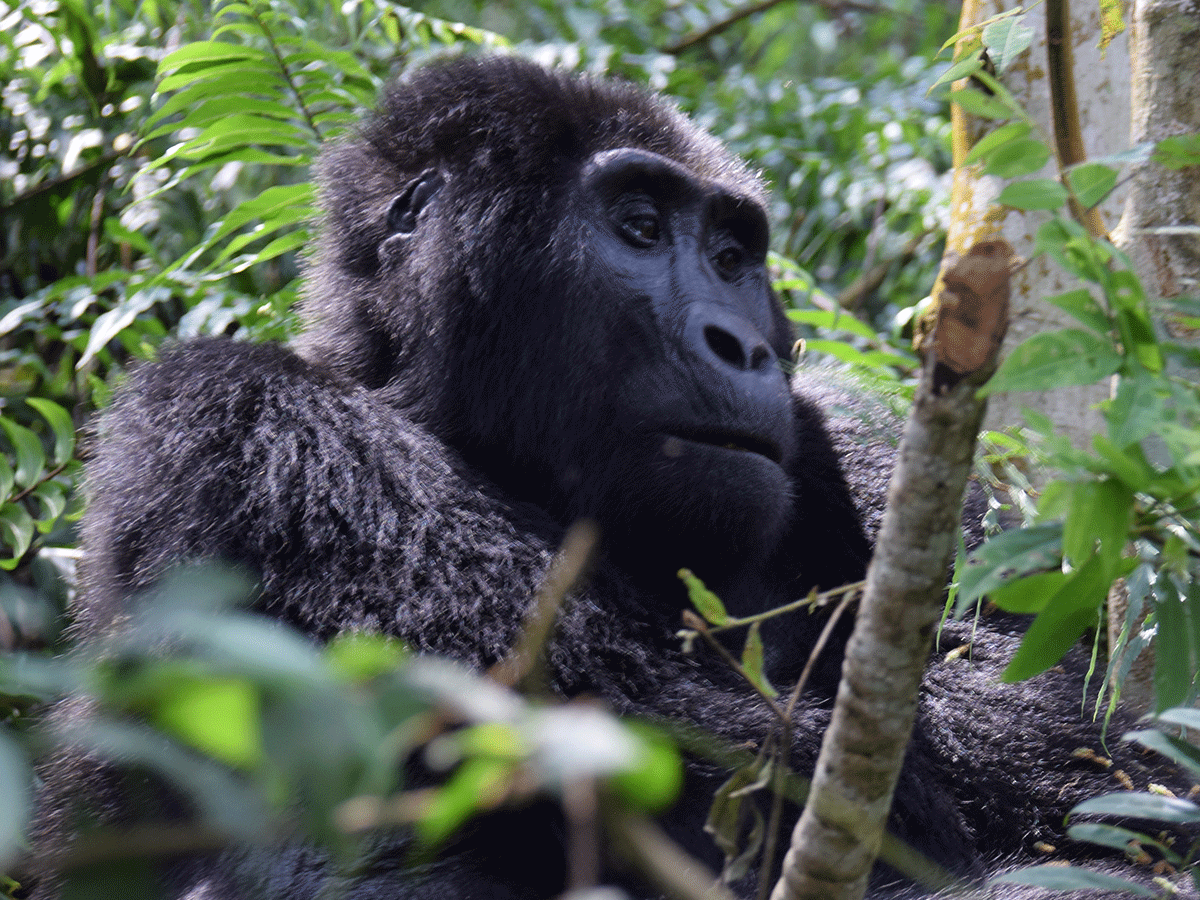Wildebeest Migration Tanzania Kenya Africa Safari
Home » African Safari Destinations » Tanzania Safaris, Tours & Holidays » Wildebeest Migration Tanzania Kenya Africa Safari
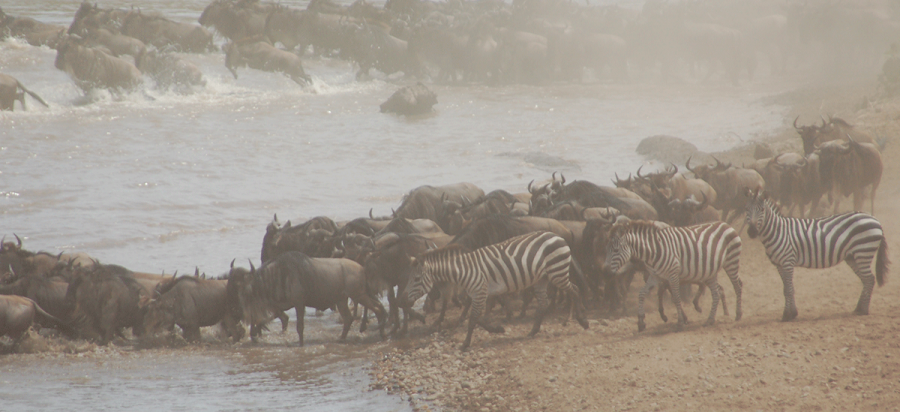
Wildebeest Migration Tanzania Kenya Africa Safari
Tanzania’s Serengeti and Kenya’s Masai Mara ecosystem form the backdrop to one of the most breathtaking events in the entire animal kingdom – The migration is even made more extraordinary by the supporting cast of predators including lions, leopards, hyena, and cheetah. The Serengeti’s southern plains host the highest concentration of predators in Africa during the wildebeest calving season (January-March). The peak of the migration is the epic and spectacular mara river crossing stage in the northern Serengeti with the raging Mara River the largest obstacle to the migration’s progress (July-September/ October depending on the rains). With millions of Hooves tormenting the ground a thunder-like Noise is hard with the dusty cloud as the herds bunch up on the riverbank before taking the plunge; The Nile Crocodiles wait for the drama as the ambitious wildebeest struggle to reach fresh grazing plains in the Masai Mara. Little do they know; the infamous Mara lions form an intimidating viciously waiting across the plains.
The wildebeest
Wildebeest, also called gnus, are members of the antelope family. They are related to oryxes and gazelles. A wildebeest can grow to 2.4 meters (8 feet) in length, and weigh up to 270 kilograms (600 pounds).
Why does the annual wildebeest migration Take Place?
Studies using aerial photography show a remarkable level of organization in the structure of the wildebeest herds as they start moving. The groups display a wavy front that snakes out like the head of a swarm. This amazing structure cannot be apparent to each individual wildebeest, which means that there is some degree of decision-making that is happening between the animals. Is there some sort of leadership being displayed; maybe a form of communication we don’t yet know about?
Some scientists believe that the wildebeest are motivated by the chemistry of the grass. The herds are attracted to higher levels of phosphorus and nitrogen, which change in response to the rains. So perhaps the wildebeest are merely following their taste.
It might simply be instinct. Fossil evidence suggests that wildebeests have been roaming the plains of East Africa for over one million years. In the same way, their body tells them to run when a lion appears out of the grass, maybe the instinct to migrate has been coded into the DNA of the animals over many years of evolution.
Whatever the reason, over 1.5 million animals begin a journey that will undoubtedly cause death to many of their own, but will also bring life to many more animals as they follow the rains in search of green nutrient-rich fields that will sustain the next generation.
Which Animals Participate in the Great wildebeest migration
Over 1.6 million wildebeest will lead the way as the rains approach in the Serengeti in late October or November and this is accompanied by 400,000 Thomson’s gazelle, 300,000 Zebra, and 12,000 Eland. These are the main migratory and they cross the ranges of over a quarter of a million other resident herbivores and, of course, carnivores. The lions, hyenas, leopards, cheetahs, and lesser predators will always follow the migration and this will be observed as more numbers of predators are seen following the wildebeest migration at the beginning of the circle.
See our popular Wildebeest Migration Tanzania Kenya Africa tours
Guide to Great wildebeest migration Tanzania & Kenya
The Wildebeest Migration is an all-year-round migration of the wildebeest across the Serengeti and the Masai mara ecosystem, here is our experts’ guide to where the wildebeest are more likely to be during the year.
January wildebeest migration Explained
In January, wildebeest and zebra herds continue to move south, mostly along the eastern edge of the Serengeti toward the fresh short grasses of the Ndutu plains, while much of the migration has already arrived in the southern Serengeti near Lake Ndutu where the animals will graze and prepare to drop their young. Large herds dot the plains as far as the eye can see and predators watch the herds closely.
February Wildebeest migration explained
In February, the calving season is in full effect as huge herds of wildebeest dot the vast grassy plains of the southern Serengeti and Ngorongoro Conservation Area, all dropping their young in a two- to a three-week span of time, with predators ever-present and ready to hunt the weak and vulnerable members of the herds.
March Wildebeest migration Explained
In March, the herds of nearly two million wildebeest and zebra remain fairly stationary; feasting on fresh grasses in the southern plains of the Serengeti and Ndutu, as their new calves grow stronger and prepare to move north. A hot-air balloon safari over the plains is a great way to get a perspective on how truly massive the herds are.
April Wildebeest migration
In April, the herds begin to journey north toward the central and western sectors of the Serengeti national park and the Grumeti River. Many camps close this month for maintenance, as April also marks the beginning of the long rains in East Africa. With the migration on the move, it can be a good time to stay in central Serengeti.
May Wildebeest migration explained
In May, the migration pushes northwest into the western corridor of the Serengeti the herds tend to stagger, with some arriving in the western reaches of the park near the Grumeti River first, while others can still be found farther south and near the central area of the park. Those that reach the western edge first tend to venture into the private Grumeti Reserve bordering the park. At the end of the month, they begin to form a mega-herd again.
June Wildebeest migration Explained
In June, a large migration herd is formed in the western Serengeti on the southern banks of the Grumeti River, with some smaller groups farther east in the central Seronera area of the park. The wildebeest and zebra tend to grow into a mega-herd before crossing the crocodile-filled Grumeti River to continue north. June also begins the rutting, or breeding, the season for the wildebeest, creating a lot of activity and excitement amongst the herds, as males exhibit their prowess and fight for female favor.
July Wildebeest migration Explained
In July, as available grasses are exhausted and begin to dry, the herds move northward for fresh grazing. With some of the herd still in the Western Serengeti and Grumeti Reserve, they continue to move northeast in search of greener plains, many arriving at the Mara River and Lamai Triangle in the northern Serengeti in mid-to late-July. These front-runners may begin the treacherous crossing of the crocodile-filled Mara River, while others graze in the northern Serengeti.
August wildebeest migration explained
In August, wildebeest and zebra herds begin their annual crossing of the Mara River, which cuts across the northwest corner of the Serengeti and up through the Masai Mara. They continue in search of fresh grasses on the other side of the river. While herds pour across the unfenced border into Kenya, some also stay in the northern Serengeti, where river crossings, though unpredictable, can be seen almost daily at this time of year.
September wildebeest migration Explained
In September, the migration herds continue to arrive and feed on the grasses in Kenya’s greater Masai mara viewing wildebeest and zebra crossing the Mara River in herds is also still a common occurrence. The abundant local wildlife only enhances the overall experience, and this is simply an excellent time of year to be in Kenya.
October wildebeest migration explained
In October, the migration can still be found in the Masai Mara and northern Serengeti as herds continue to graze in large numbers with lions and other predators always in the vicinity. River crossings can still be seen on occasion. As the short rains begin to brew toward the end of October, the first of the herds begin to journey back south along the eastern edge of the Serengeti and Loliondo following new grasses.
November wildebeest migration explained
In November, the short rains have begun to fall, and the bulk of the migration herds move quickly south with the goal of reaching the short-grass plains once again. The mega-herd breaks into pockets of wildebeest and zebra that can be found in the northern Serengeti moving to the central Seronera plains, while many are found along the eastern border near the private reserves of Loliondo.
December wildebeest migration explained
In December, the migration continues moving south toward the short-grass plains of Ndutu in the Ngorongoro Conservation Area. Some herds can be spotted in the central and eastern Serengeti as they move south, while early arrivals can be found already in Ndutu feasting on fresh grasses. This is a nice time to see large herds thundering across the plains and beginning to gather in the south.
You might also like
Guide to where to stay during the Great wildebeest migration Tanzania & Kenya
February –March (Ndutu plains Serengeti)
- Activity: calving season in Serengeti.
- Lodge: Serengeti safari camp and Ubuntu camp.
April, May and June (Simba kopjes, moru and kusini)
- Activity: Wildebeest start their journey, Masai Mara).
- Lodge: Ole serai luxury camp.
July-August-early September Kogatende and Lamai triangle
- Activity: (epic and spectacular Mara River crossing).
- Lodge: Nomad Lamai Serengeti
October (Masai Mara plains)
- Activity: survivors celebrate their success and the non-survivors perish in the brown waters.
- Lodge option: Nomad Lamai Serengeti.
November (South and East of Seronera and Ndutu area)
- Activity: Journey back to the Serengeti starts for the short green grass.
- Lodge: Nomad Lamai Serengeti.
December-January (north-eastern Serengeti in the Lobo area)
- Activity: the cows prepare for the calving season).
- Lodge: Klein’s camp or Lobo mobile camps.
Booking the Great wildebeest migration Tanzania & Kenya
Clients must take note that during July, August, September, and October safari lodges are fully booked in prime wildlife viewing areas so booking this safari in Advance is key to getting the best places to stay.
Practically when are the chances high to witness the River crossing
It’s very tricky to tell when the wildebeest will start crossing between July and August but your chances are relatively higher at the end of July and August.
Mid-February to march is also a perfect time to witness the action-packed wildebeest calving season in the Ndutu plains.
Travelers tips for a perfect wildebeest migration safari
It’s important to note that the annual wildebeest migration safari is best when staying at the mobile camps across the Serengeti and the Masai Mara Ecosystem.
Being one of the wonders of the world the great wildebeest migration safari attracts many travelers between mid-June and early October so an advance booking of at least a year may be required in order to select and secure the action-packed areas during the migration.
To be on top of this adventure clients can book a gorilla tracking safari a few weeks after the beginning of July before arriving at the Serengeti in time for the spectacular river crossing-we may be able to provide clients with a tip of what is happening as of that mid-July through our guides on the state of the migration meaning if the wildebeest have started crossing or not.
It’s best to combine both Serengeti safari and Masai Mara safari during the wildebeest migration safari.
This is considered a trip of a lifetime however we advise clients to prepare the way in advance to get the best of the safari for more information contact Wilderness Explorers Africa your Africa travel specialist.
See our East African safaris Featuring Wildebeest
THINGS TO DO
| Wildebeest Migration and gorilla trekking Combined |
| Game drives in Serengeti and Masai mara Plains |
| Wildebeest Migration and Zanzibar Beach holidays |
| Wildebeest Migration and Dian Beach Combined |
| wildebeest Migration and Solio reserve combined |
| Wildebeest Migration and Rwanda gorilla trekking Combined |
| Wildebeest Migration and Uganda gorilla trekking combined |
| Wildebeest Calving season and gorilla trekking combined |
| wildebeest Migration and Mombasa fishing combined |
WHERE TO STAY
Kogatende area in serengeti
| Mara river in Masai mara national reserve |
| Ndutu plains in Serengeti national park |
| Lamai triangle Serengeti national park |
| Maswa Game reserve Tanzania |
WHEN TO GO
| Best time to witness wildebeest Migration in Tanzania & Kenya |
SAFARI PACKAGES
| 7 Days Tanzania wildebeest Migration safari |
| 7 Days Kenya wildebeest Migration safari |
| 9 Days Tanzania and Kenya wildebeest Migration safari |
| 9 Days Tanzania wildebeest Migration & Zanzibar beach safari |
| 9 Days Kenya wildebeest Migration and Dian beach safari |
| 13 Days Kenya,Tanzania wildebeest and Rwanda gorilla safari |
| 13 Days Tanzania, Kenya and Uganda wildebeest Migration safari |
| 14 Days Filming Kenya and Tanzania wildebeest Migration |
| 14 Days photographing the Kenya and Tanzania Wildebeest Migration |

